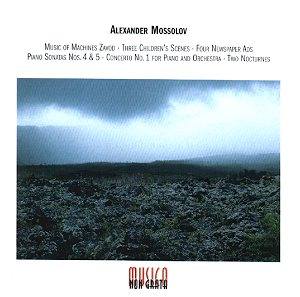
The Iron Foundry is a well known piece. It enjoys an oddity reputation
and is rarely heard. Recordings have been few and far between. This seems
to be the most recent. There are times when the intertwining rhythmic figures
suggest an early example minimalism. Whirring machinery hammers away and
horns stride across the aural texture in manic intensity. This is music of
a metallic nightmare. The recording was made in concert and ends in a tumult
of applause. The piece reminded me of Prokofiev's Scythian Suite.
The Three Children's Scenes are here given in an orchestration by
Edison Denisov. The howling reminded me of Britten's strongest song cycle
Our Hunting Fathers. The piece has some heart unlike the
Foundry. The soprano (Nelly Lee) is good with a bell clear voice.
The words are by Mossolov himself. The Newspaper Ads vary in approach
from Russian operatic to viridian clockwork energy.
Tunes fly out in sparks and long molten lines in the single movement fourth
piano sonata. The strenuous piano writing sounds at times like a brick thrown
at an adamantine crystal wall is in one movement. In there amongst the clangour
is an extremely romantic theme engulfed in the din of gargantuan broken bells
and sledge-hammer assaults.
The fifth sonata is in four movements mixing a goaded chase and nocturnal
whispers. At 3:12 a sweet tune floats to the surface right out of children
songs. The second movement emulates a muffled drumbeat and melts into a
netherworld elegy where the curlew cries out. The scherzo marziale is
irritable and heated like hot acid flowing in full spate. The finale is the
single largest movement deploying a theme similar to the main romantic theme
in the fourth sonata. The bass is rooted in great muscular strength. Dies
Irae puts in an appearance. The music suggested to me some great Russian
abbey.
The piano concerto starts with a nightmare scene - all gore, bandages and
ghouls scavenging a corpse-littered battlefield. More than a few moments
are indebted to Ravel. At 2:50 a Rite of Spring beat rears up. There
is some humour in this but not much and what is there is pretty dark. The
big central movement offers chamber textures and a sliding violin leaning
towards the screechy avant-garde. The finale is a slurry of oily black notes.
This is not a loveable work.
The Two Nocturnes comprise an irate toccata. Cascades of heavily perfumed
notes dominate the second nocturne.
The well laid out booklet offers plentiful background.
A good and generous collection filling in a gap in the history of Russian
music of the 1920s. The Foundry and piano sonatas are the strongest
works on the disc.
Reviewer
Rob Barnett

